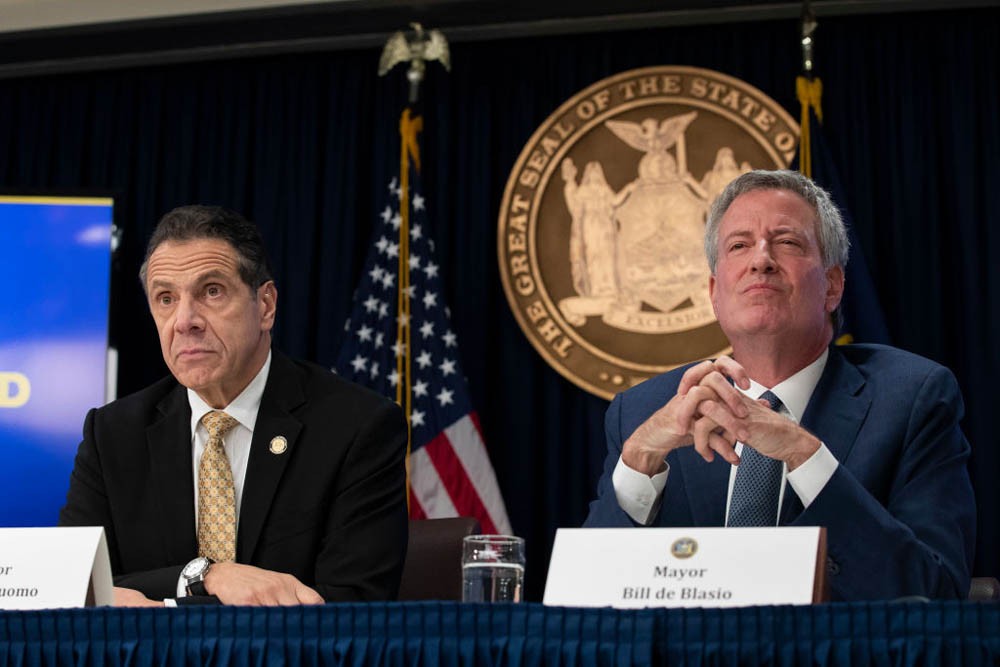Taking the bus? Sitting in traffic on the Manhattan Bridge? You may think you are just getting around town. But you are a conscript on the biggest battlefield between Gov. Cuomo and Mayor de Blasio in their struggle for political primacy: the transportation system.
It’s nothing new: State and city have fought over who controls the streets and the train tracks since the Great Depression.
But the upcoming battle — over congestion pricing — will be the biggest fight of the kind since the late 1960s, when master builder Robert Moses finally lost control of the city’s major road decisions. In a breathtaking irony, Cuomo is using the ghost of Moses’ old agency to wrest such power back.
Congestion pricing is economically sound. Manhattan’s streets are crowded; many drivers and Uber riders should be taking mass transportation. Yet subways are also crowded and don’t serve outlying areas. Presto: Charge the drivers and give money to the subways and buses.
That’s what then-Mayor Mike Bloomberg proposed in 2007, to be thwarted by a corrupt Albany. Now Cuomo has embraced the same idea. But has he?
There’s a catastrophic difference between these two plans. In 2007, the city was in charge. The council voted a home-rule message to the state. All the state had to do was give permission. Yes, much of the money would go to the MTA — but some would stay, to keep up local street infrastructure.
This makes sense. With few exceptions, the city owns the “free” streets and bridges that bring people into the Manhattan congestion zone, including the East River bridges and the Brooklyn-Queens Expressway.
Major roads and bridges aren’t actually free: City taxpayers spend $1.5 billion annually to maintain them, a figure that will rise to $3.2 billion by 2022.
Cuomo isn’t proposing to give Gotham the tools to charge drivers to use the city’s own resources. Rather, he’s proposing a hostile takeover of New York’s roads, a la Moses of the mid-20th century.
In his budget proposal this month, the governor called for the Triborough Bridge and Tunnel Authority to “plan, design, and construct the congestion-tolling infrastructure” throughout New York City. “Triborough,” the budget states, “may occupy the sidewalks, roadways, streets, highways, bridges, tunnels, approaches, or highways [sic] of the city of New York, without the consent of or payment to the city of New York.” It can even work without construction permits.
What’s the city’s only role? “The city of New York shall cooperate fully.”
No kidding: The city has no control whatsoever over Triborough. It is a Metropolitan Transportation Authority entity, the seat of Moses’ power. Moses used Triborough to saturate New York with cars, via the Triborough Bridge, the Queens-Midtown Tunnel and other crossings.
Moses eventually lost his power when he went too far: failing in his proposal to crisscross Soho with a major “Lower Manhattan Expressway” in the mid-1960s. But it took a lot of damage — and a popular new mayor, John Lindsay — to help stop him.
Today the governor effectively proposes to take the city’s own road assets — infrastructure worth tens of billions of dollars — and sign the new money they earn over to Triborough.
It gets worse: None of the cash will go to maintain the city roads and bridges that create the new windfall. Rather, the money will go right to Triborough, which can use it to support bonds that fund “any [MTA] capital projects.”
Translation: Some of the city’s money could go to suburban wishes — and given how much the city already subsidizes expensive projects such as East Side Access, it likely will.
The problem isn’t just money; it’s control of space. New York has spent the past decade building bike lanes and pedestrian plazas. What if a future governor, under pressure from drivers to increase road space for cars, uses the new right to “occupy the sidewalks, roadways [and] streets,” to rip them out, in the name of managing congestion pricing?
This would be a huge deal even if the state were offering something in return: a bigger say over how the MTA spends our money. Instead, Cuomo has said that he’d like more control over the MTA. More money from the city — and more dominance over its future.
Moses must be smiling down — or up — at us. He didn’t much like transit, but he did like power. Cuomo is proposing to give the very streets to Moses’ creation — something even Moses wouldn’t have attempted. It would be nice if we had a mayor who intuitively grasped this as well as Cuomo does.
This piece originally appeared at the New York Post
______________________
Nicole Gelinas is a senior fellow at the Manhattan Institute and contributing editor at City Journal. Follow her on Twitter here.
This piece originally appeared in New York Post
